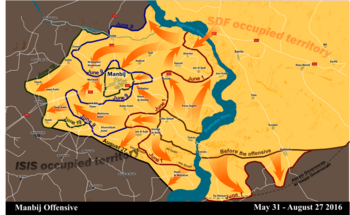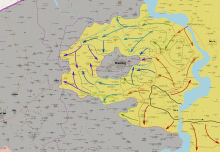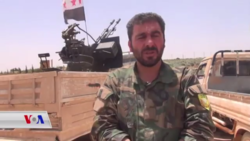
A | B | C | D | E | F | G | H | CH | I | J | K | L | M | N | O | P | Q | R | S | T | U | V | W | X | Y | Z | 0 | 1 | 2 | 3 | 4 | 5 | 6 | 7 | 8 | 9
| Manbij offensive (2016) | |||||||
|---|---|---|---|---|---|---|---|
| Part of the Rojava–Islamist conflict and the American-led intervention in the Syrian Civil War | |||||||
 Map showing SDF territorial gains during the offensive | |||||||
| |||||||
| Belligerents | |||||||
|
|
| ||||||
| Commanders and leaders | |||||||
|
(Council general commander & Northern Sun Battalion deputy commander)[11] (Northern Sun Battalion commander) (Northern Sun Battalion security officer, alleged) (Manbij Revolutionaries Battalion commander) (Manbij Revolutionaries Battalion commander) (YPJ commander) (Jarabulus Military Council and Euphrates Jarabulus Brigades chief commander) (Jarabulus Military Council commander) (YPG commander)[21] (SDF senior commander) (SDF commander) (SDF commander) (SDF commander) (SDF commander) (SDF commander) (SDF commander) (SDF commander) (YJÊ commander) |
(Emir of Manbij) (1st replacement Emir of Manbij) (2nd replacement Emir of Manbij) (commander of Manbij by August) (Emir in Manbij) (Emir of Um Mayyal) (ISIL senior leader) (commander of western Manbij) (commander of eastern Manbij) (ISIL senior commander) (ISIL senior commander) (Hisba police chief of Manbij) (ISIL field commander) (pro-ISIL tribal leader) (security official of Manbij) (prominent battalion commander) | ||||||
| Units involved | |||||||
|
| |||||||
| Strength | |||||||
|
|
Several thousand fighters | ||||||
| Casualties and losses | |||||||
|
315 killed (SOHR claim)[71] 1,650 killed (ISIL claim)[72] 264 killed (SDF claim)[73] 700–1,000 killed (other claims)[74] |
1,026 killed (SOHR claim)[71] 400 killed (ISIL claim)[72] 4,180 killed, 112 captured (SDF claim)[73] | ||||||
|
444 civilians killed[71] and 2,000+ abducted[75] ~78,000 civilians displaced[76][77][78] | |||||||
The Manbij offensive, code-named Operation Martyr and Commander Faysal Abu Layla by the SDF, was a 2016 military offensive operation by the Syrian Democratic Forces (SDF) to capture the city of Manbij from the Islamic State of Iraq and the Levant (ISIL), and eventually, the ISIL-held areas through Al-Bab to Herbel, in the area referred to as the "Manbij Pocket"[n 1][80] in the northern Aleppo Governorate.[81] The main goal of the offensive was to cut off ISIL's last supply routes from Turkey, and to prevent ISIL fighters from escaping across the Syria-Turkey border.[58][82][83] For the first five days of the offensive, the US-led coalition conducted over 55 airstrikes in support of the SDF.[82] After capturing Manbij city on 12 August, the SDF announced that the offensive would continue until the whole countryside around Manbij was captured,[1] though the offensive effectively ended shortly after the Turkish Armed Forces initiated Operation Euphrates Shield to prevent the SDF uniting the regions of Rojava.[84]
Preparations

In late December 2015, the SDF captured the Tishrin Dam and crossed the Euphrates, capturing the town of Tishrin and other nearby areas from ISIL, paving the way for a future offensive toward Manbij.
By 30 March 2016, the United States Air Force had conducted 25 airstrikes against the Islamic State.[3] On 2 April, six non-YPG factions of the Syrian Democratic Forces (SDF) formed the Manbij Military Council (MMC) in preparation for the attack on Manbij. Most of the groups were part of the Northern Sun Battalion.[47][85][86]
On 3 April, the U.S. asked for Turkey's support for the Manbij offensive, but the Turkish government made two demands in exchange for helping the international military intervention against ISIL; first, that the Syrian Arab tribes to be included in the Manbij operation should leave the SDF, and second, that the U.S. should increase its airstrikes in support of Turkish-backed Syrian rebels.[87] On 4 April, according to a Turkish source, a group of U.S. military and intelligence staff traveled to Turkey to work on a plan for an operation to capture Manbij.[87] The Turkish government later stated that it would not participate nor contribute to the offensive,[88] because of the involvement of the Kurdish-majority People's Protection Units (YPG), and because it was beyond the range of artillery stationed in Turkey.[89][90] When the offensive started, the Washington Post reported it under the headline of "Ignoring Turkey, U.S. backs Kurds in drive against ISIS in Syria".[91]
On 5 April, a civilian council was formed in the town of Sarrin under the auspices of the Autonomous Administration of North and East Syria, of Manbij people who had fled when the Islamic State took over. The council consisted of Arabs, Kurds, Syrian Turkmen, and Circassians,[92] and was created to administer Manbij after its capture.[93] When international media interest in ethnic issues surged after the start of the offensive, Sheikh Farouk al-Mashi, an Arab former member of the Syrian parliament and designated co-chairman of the Manbij City Council, stated: "I have a Syrian ID, and Kurds have a Syrian ID. Let those people who talk against us in Turkey and Europe come here and fight ISIS. Why this distortion in media about problems between Kurds and Arabs?" Kurdish fellow co-chairman Salih Haji Mohammed stated: "In our social contract, we say we want to have good relations with neighboring countries like Turkey. Any country that does not interfere in Manbij and our areas, we will have good relations with."[24]
On 31 May, the US announced that they would support the offensive and send supporting troops to the area. A US official stated that "Syrian Arab fighters would be the ones to stabilize and secure it once Islamic State is gone".[94] The same day the offensive started, the Syrian Observatory for Human Rights (SOHR) stated "most of the fighters were from the Kurdish Popular Protection Units (YPG) militia".[95] However, the next day, Turkish President Recep Tayyip Erdoğan said that around 3,000 SDF fighters were joining the operation and that some 2,500 of them were Arabs, while around 450 were from the YPG.[90] Furthermore, two coalition spokesmen reiterated Arab fighters were leading the offensive, while Kurdish forces were in support, and one stated the reports that were suggesting the offensive was Kurdish-led were inaccurate.[64][65] Another report stated, per local activists, that 60 percent of the attacking force were Arabs from Manbij.[67] This was also confirmed by a MMC commander, who said that 60 percent of the attacking force were Arabs and 40 percent Kurds, Turkmen and other ethnic groups,[24] while an SDF fighter gave his perspective as "we have Arabs, Kurds, nobody knows how many exactly, we all work under the SDF-forces".[96]
The offensive
The SDF capture the eastern countryside
On 31 May 2016, the Syrian Democratic Forces launched the offensive for the "Manbij Pocket" (al-Shahba) region, with small numbers of US Special Forces assisting with tactical operations and planning near the frontlines.[58][97][98][99] The SDF captured three villages and the al-Gharra Mountain from ISIL, located southeast of the ISIL stronghold of Manbij. This advancement put the SDF and YPG within 15 kilometres of Manbij.[100] The offensive was launched from two directions, from the Tishrin Dam area and the ruins of the Qara Qozak Bridge, near Sarrin. It was reported that US Special Forces constructed an Armoured vehicle-launched bridge (AVLB) at the site of the destroyed Qara Qozak Bridge, to enable SDF forces to cross the Euphrates River.[101] On 1 June, the SDF captured Najam Castle, on the west bank of the Euphrates River, across from Sarrin, and linked the two fronts east of Manbij, advancing along the M4 Highway and the west bank of the Euphrates.[102][103] These advances nearly doubled the SDF-held territory near Manbij since the start of the offensive,[103] and brought the SDF within 12 kilometers of Manbij.[104]
On 3 June, Abu Layla, a leading commander of the Manbij Military Council, was severely injured during the clashes with ISIL. He was subsequently moved to Sulaymaniyah in Iraqi Kurdistan for treatment[105] but he died of his wounds two days later;[12] the offensive was subsequently named after him in his honor. By this point, SDF forces had captured around 50 villages and almost 400 square kilometers of land from ISIL, within the past week.[106]
Encirclement of Manbij

On 4 June, the SDF captured another eight villages,[25] and cut the road between Manbij and Ar-Raqqah.[107][108] Heavy fighting continued on 5 June, five kilometers from Manbij.[65] On 5 June, the SDF captured the village of Awn Dadat, north of Manbij, severing the Jarabulus-Manbij road. SDF forces also captured Khirbat Hisan, Malla Saad, and Safiya, to the north of Manbij, killing dozens of ISIL militants.[109] By early 6 June, it was reported that the SDF had captured 10 more villages from ISIL near Manbij, including Kabir al-Kabir, located 5 km south of Manbij, putting ISIL in a state of high alert. Due to the SDF advancement and the ongoing encirclement of Manbij, ISIL was reportedly beginning to transfer fighters from the Azaz frontline to Manbij, in order to reinforce their positions against the SDF.[110]
On 6 June, ISIL fighters were reportedly fleeing Manbij with their families,[111] while ISIL attempted to regain control over Om Ezam village and its vicinity.[112] That day, the SDF took the Jarabulus-Manbij road and two villages east of Manbij.[113] By the evening, SDF fighters were within two kilometers south of Manbij.[114] Furthermore, two ISIL leaders were killed by airstrikes on Jarabulus: Abu Huzaifa Alordoni and Hasan Rimo.[42]
On 7 June, the SDF captured six more villages and farms around Qara Qoqaz bridge.[115]
On 8 June, ISIL started to abandon its frontline against the Turkish-backed rebels north of Aleppo to reinforce Manbij, while the SDF captured two more villages.[116] That morning, the rebels launched surprise simultaneous attacks from Mare' and Azaz to push back ISIL forces, which offered only token resistance.[117]

On 9 June, the SDF was trying to complete its siege on Manbij, advancing on its eastern, northern and southern side, capturing several villages in the progress.[118] Later that day, SDF forces reached the Manbij-Aleppo road; the last major route going out of the city.[119] According to the Syrian Observatory for Human Rights (SOHR), 49 ISIL militants and one SDF fighter were killed in the past 36 hours.[120] The SDF announced that the emir of Manbij, Osama al-Tunisi, was among the ISIL casualties, releasing footage of his corpse.[29] According to local activists and SDF officials, Osama had attempted to escape from the city to Al-Bab with his family and bodyguards; all of them were subsequently killed by SDF artillery bombardment. ARA News reported that Osama al-Tunisi's escape attempt and death "indicates the collapse of ISIS in the city under the ongoing operation by the western-backed SDF troops".[121] Nevertheless, ISIL forces launched a limited counter-offensive south of Manbij on the same day, claiming to have retaken a small number of villages.[122] Osama al-Tunisi was subsequently succeeded by Abu Khalid al-Tunisi as new Emir of Manbij.[30]
On 10 June, Manbij was completely besieged by the SDF, with all of the routes leading to Manbij cut off by SDF forces,[76] trapping 2,000 ISIL fighters[70] and several thousand civilians inside the city.[123] Meanwhile, SDF forces continued to advance west of Manbij, reaching within 17 kilometers of Al-Bab by 11 June.[124]
The next day, SDF fighters advanced further, attacking the village of Um Mayyal, which served as ISIL headquarters for the countryside west of Manbij. In course of the following fierce battle, Dahham al-Hussein, ISIL emir and field commander, was killed and the village taken by the SDF.[36] Between 12 and 13 June, an ISIL counterattack reportedly recaptured six villages around Manbij.[125] On 13 June, it was reported that before their withdrawal from the countryside of Manbij, ISIL militants broke into civilians' houses in dozens of villages, killing the men and raping the women.[126]
By 14 June, the SDF had captured 105 villages and farms, while intense airstrikes targeted the northern and eastern vicinity, and outskirts of Manbij city, to prepare for the eventual assault on the city.[127] Following a report by the Syrian Observatory for Human Rights,[4] the Syrian government "strongly condemned" the presence of French and German special forces on Syrian territory. While France's defense minister had previously announced its special forces would help the SDF advance towards Manbij, a German Foreign Office spokesman declared the accusation to be "false", stating that there were no German special forces.[5]
According to sources given to journalist Vincent Nouzille, French Special Forces alongside operators from the Directorate-General for External Security (DGSE) were particularly involved in the fighting, with "dozens" of ground operations in the area.[128] Former French President François Hollande would later admit in an interview that "the defense council showed a willingness on the part of the general staff to take on more and more special operations and those of the DGSE to continue its very military actions."[129]
On 15 June, ISIL launched another breakout attempt from Manbij city, reportedly recapturing two nearby villages.[130] The next day, SDF forces were not only able to reverse the recent ISIL gains, but also captured two more villages near Manbij, Tal Rafi'i and Yaleeni, after hard fighting with ISIL defenders.[131] SDF troops also advanced into Manbij, capturing the city's Hatabat district. In course of the fighting, ISIL's local Hisba police chief, Abu al-Hayjaa, was killed by SDF fighters.[41]
On 17 June, heavy clashes were reported at the western entrance of Manbij,[132] while SDF forces continued to advance against the remaining ISIL-held villages at the city's outskirts. SDF commanders claimed that some ISIL fighters disguised themselves as women in an attempt to flee the encircled city.[26] Later on the same day, SDF forces entered the western part of Manbij city, killing over 26 ISIL militants.[133] By this point, several Arab tribes of the Shahba region had also joined the SDF after a secret meeting.[50]
Battle in Manbij's outskirts

On 18 June, SDF forces reached the western entrance of Manbij, two kilometers from the city center,[134] in the process inflicting heavy casualties on ISIL, including two killed senior commanders.[40] By the next day the SDF had secured the crucial Al-Kitab crossroad in western Manbij, while they continued to assault the ISIL-held villages of Yasta and Eyn En-Nexîl northeast of the city.[135] The two villages were eventually captured after heavy clashes, depriving ISIL forces of their last strongholds in Manbij's outskirts.[136] Subsequently, a SDF field commander claimed that the SDF had captured all villages around Manbij from ISIL, and that the situation for the besieged forces in the city became dire. He reported that some ISIL emirs had attempted to bribe the SDF to let them flee the city.[15] Furthermore, clashes between SDF and ISIL took place near al-Kawkali and al-Arima, where ISIL forcibly conscripted 200 locals to fight against the SDF.[137]
The next day, the coalition intensified their airstrikes in order to assist the SDF, while the latter continued to advance into Manbij. In course of these airstrikes, Abu Hamza al-Ansari, another leading ISIL commander of the city, was killed. Despite their losses, ISIL forces reportedly continued to defend their positions in Manbij fiercely.[37]
On the morning of 20 June, ISIL fighters attacked forces of the SDF from the side of al-Bab, Jarabulus and the village of Arima in an attempt to break the siege of Manbij. The clashes continued until the afternoon,[27] with ISIL forces retaking three villages[138] before they were repelled by SDF forces. Both sides suffered heavy casualties, with the SDF losing 28 fighters[139] and ISIL suffering over 140 dead and much lost matériel.[27][54] As a result of the SDF advance, ISIL initiated mass arrests of Kurdish civilians in many towns and villages of the northern Aleppo countryside. Activists expressed fear that the civilians would be used as human shields.[140] In two villages, the locals revolted against ISIL fighters when they attempted to kidnap women, resulting in clashes that left six civilians dead.[141]
With some western parts of the city on Manbij proper under SDF control, a humanitarian corridor was opened between the city and its captured countryside on 22 June in order to assist civilians evacuating the city.[142]
The next day, SDF broke into the Manbij Silos, one of the most important ISIL strongholds in the city.[143] According to U.S. officials, despite their recent defeats ISIL forces in Manbij did not show signs of faltering and were expected to fight till the last for the city.[144]
By 23 June, while there were heavy clashes in the outskirts, the SDF further advanced into the town.[145] SDF forces broke into the city's southern perimeter resulting in heavy street fighting. Two SDF fighters were killed by an explosive device.[146] Al-Masdar News reported that "hundreds" of ISIL fighters still remained in the city, "with many locals volunteering to become suicide bombers". Furthermore, the number of abducted Kurdish civilians in the northern Aleppo countryside had risen to 900.[147]
Zdroj:https://en.wikipedia.org?pojem=Manbij_offensive_(2016)Text je dostupný za podmienok Creative Commons Attribution/Share-Alike License 3.0 Unported; prípadne za ďalších podmienok. Podrobnejšie informácie nájdete na stránke Podmienky použitia.
Antropológia
Aplikované vedy
Bibliometria
Dejiny vedy
Encyklopédie
Filozofia vedy
Forenzné vedy
Humanitné vedy
Knižničná veda
Kryogenika
Kryptológia
Kulturológia
Literárna veda
Medzidisciplinárne oblasti
Metódy kvantitatívnej analýzy
Metavedy
Metodika
Text je dostupný za podmienok Creative
Commons Attribution/Share-Alike License 3.0 Unported; prípadne za ďalších
podmienok.
Podrobnejšie informácie nájdete na stránke Podmienky
použitia.
www.astronomia.sk | www.biologia.sk | www.botanika.sk | www.dejiny.sk | www.economy.sk | www.elektrotechnika.sk | www.estetika.sk | www.farmakologia.sk | www.filozofia.sk | Fyzika | www.futurologia.sk | www.genetika.sk | www.chemia.sk | www.lingvistika.sk | www.politologia.sk | www.psychologia.sk | www.sexuologia.sk | www.sociologia.sk | www.veda.sk I www.zoologia.sk
